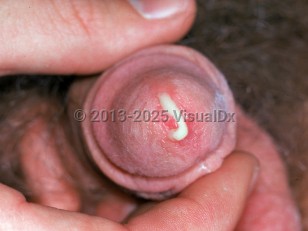Primary gonorrhea infection - Anogenital in
See also in: OverviewAlerts and Notices
Important News & Links
Synopsis

Gonorrhea is a common sexually transmitted infection (STI) caused by the gram-negative intracellular diplococcus Neisseria gonorrhoeae. It is highly contagious and primarily spread through sexual contact, although it can also be passed to the fetus from a pregnant person during childbirth or via indirect contact through sharing of contaminated objects. There appears to be a higher rate of gonorrheal infection in women than men, although the overall incidence is likely underreported.
The incubation period of N gonorrhoeae is short. The average time from infection to symptom onset is approximately 2-7 days. Risk factors for acquiring N gonorrhoeae include having a new sex partner, more than one sex partner (or a sex partner with concurrent partners), and a history of STIs (or a sex partner with a history of STIs). Other risk factors include inconsistent condom use (if not in a mutually monogamous relationship), young age, and substance abuse. Some subgroups of men who have sex with men (MSM) are at higher risk as well.
The endocervical canal is the most common site of infection in women. Symptoms typically include dysuria, vaginal discharge, bleeding, and menstrual pain. Pelvic inflammatory disease (PID) occurs in 20% of patients as a result of ascending endocervical infection. Clinical features of PID include lower abdominal and adnexal pain, fever, and leukocytosis. Rarely, PID can cause further peritoneal and hepatic inflammation, leading to right upper quadrant pain and gonorrheic perihepatitis (Fitz-Hugh-Curtis syndrome). Chronic untreated PID may lead to tubal scarring with resultant infertility or ectopic pregnancy.
Proctitis and pharyngitis occurs in both sexes via direct mucosal infection, but the former is more prevalent in MSM.
Systemic symptoms including fever, arthritis, tenosynovitis of large joints, and cutaneous pustules can occur from hematogenous dissemination. This occurs in less than 1% of patients. Risk factors for dissemination include menstruation and complement deficiency.
Related topics: disseminated gonorrhea, gonococcal cervicitis, gonococcal conjunctivitis
The incubation period of N gonorrhoeae is short. The average time from infection to symptom onset is approximately 2-7 days. Risk factors for acquiring N gonorrhoeae include having a new sex partner, more than one sex partner (or a sex partner with concurrent partners), and a history of STIs (or a sex partner with a history of STIs). Other risk factors include inconsistent condom use (if not in a mutually monogamous relationship), young age, and substance abuse. Some subgroups of men who have sex with men (MSM) are at higher risk as well.
The endocervical canal is the most common site of infection in women. Symptoms typically include dysuria, vaginal discharge, bleeding, and menstrual pain. Pelvic inflammatory disease (PID) occurs in 20% of patients as a result of ascending endocervical infection. Clinical features of PID include lower abdominal and adnexal pain, fever, and leukocytosis. Rarely, PID can cause further peritoneal and hepatic inflammation, leading to right upper quadrant pain and gonorrheic perihepatitis (Fitz-Hugh-Curtis syndrome). Chronic untreated PID may lead to tubal scarring with resultant infertility or ectopic pregnancy.
Proctitis and pharyngitis occurs in both sexes via direct mucosal infection, but the former is more prevalent in MSM.
Systemic symptoms including fever, arthritis, tenosynovitis of large joints, and cutaneous pustules can occur from hematogenous dissemination. This occurs in less than 1% of patients. Risk factors for dissemination include menstruation and complement deficiency.
Related topics: disseminated gonorrhea, gonococcal cervicitis, gonococcal conjunctivitis
Codes
ICD10CM:
A54.9 – Gonococcal infection, unspecified
SNOMEDCT:
15628003 – Gonorrhea
A54.9 – Gonococcal infection, unspecified
SNOMEDCT:
15628003 – Gonorrhea
Look For
Subscription Required
Diagnostic Pearls
Subscription Required
Differential Diagnosis & Pitfalls

To perform a comparison, select diagnoses from the classic differential
Subscription Required
Best Tests
Subscription Required
Management Pearls
Subscription Required
Therapy
Subscription Required
References
Subscription Required
Last Reviewed:09/12/2021
Last Updated:09/19/2021
Last Updated:09/19/2021
 Patient Information for Primary gonorrhea infection - Anogenital in
Patient Information for Primary gonorrhea infection - Anogenital in
Premium Feature
VisualDx Patient Handouts
Available in the Elite package
- Improve treatment compliance
- Reduce after-hours questions
- Increase patient engagement and satisfaction
- Written in clear, easy-to-understand language. No confusing jargon.
- Available in English and Spanish
- Print out or email directly to your patient
Upgrade Today

Primary gonorrhea infection - Anogenital in
See also in: Overview
